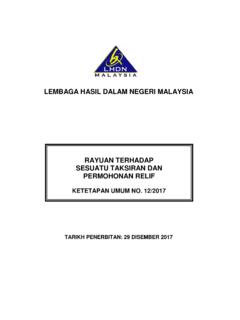Transcription of 251 Acute Liver Failure in Critical Care - FRCA
1 Sign up to receive ATOTW weekly - email ATOTW 251 Management of Acute Liver Failure in Critical care 20/02/2012 Page 1 of 9 MANAGEMENT OF Acute Liver Failure IN Critical care ANAESTHESIA TUTORIAL OF THE WEEK 251 20TH FEBRUARY 2012 Dr Paul Maclure, University Hospital, Coventry, UK Dr Bilal Salman, Warwick Hospital, Warwick, UK Correspondence to QUESTIONS Before continuing, try to answer the following true or false questions. The answers can be found at the end of the article, together with an explanation 1.
2 Concerning Acute Liver Failure (ALF): a. Paracetamol toxicity is the commonest cause of ALF worldwide b. Hyperacute presentations of ALF are associated with poorer outcomes c. Albumin is a good marker of Acute Liver Failure d. All patients with ALF should receive prophylactic antibiotics 2. The following are poor prognostic markers in ALF: a. Prothrombin time > 100 seconds b. Elevated serum ammonia levels c. Underlying aetiology of paracetamol toxicity d. Prolonged period between the onset of jaundice and encephalopathy 3. The following are diagnostic criteria for ALF: a.
3 Absence of chronic Liver disease b. Acute transaminitis (ALT/AST) c. Coagulopathy with INR > d. Evidence of encephalopathy e. Illness duration < 28 days d. Concerning the management of neurological complications in ALF: a. Target PaCO2 is that of low-normal range b. Hypertonic saline is a recognised treatment for cerebral oedema c. All patients should have invasive intra-cranial pressure monitoring d. Sedation and ventilation is recommended for grade 3 encephalopathy and above INTRODUCTION Acute Liver Failure (ALF) is a rare, life-threatening multisystem illness resulting from severe hepatic injury from a variety of potential aetiologies (Figure 1).
4 The potential for multi-organ Failure makes ALF an extremely challenging disease to manage. Despite advances in the understanding of the aetiology and pathogenesis of the condition mortality rates remain high. In the most severe cases emergency Liver transplantation is the only option. The Intensive care Unit has a pivotal role in the management of this condition by providing support for failing organs while allowing time for hepatic regeneration or for pre-optimisation prior to Liver transplantation.
5 Sign up to receive ATOTW weekly - email ATOTW 251 Management of Acute Liver Failure in Critical care 20/02/2012 Page 2 of 9 This tutorial explores the practical management of ALF in the Critical care setting and aims to provide a structured approach to management of these patients. Figure 1. Common causes of Acute Liver Failure in the developed world. Data obtained from United States of America, however this list is representative of the majority of developed countries. AETIOLOGY AND DEFINITION Determining the aetiology of ALF is a primary concern in the management of this condition because it can influence management and help to predict outcome.
6 N-acetylcysteine (NAC) for paracetamol (acetaminophen) overdose, delivery of the foetus for HELLP or fatty Liver of pregnancy, and treatment with lamivudine in Hepatitis B viral infection are examples of disease-specific therapies. These need to be instigated promptly to guide further management and reduce morbidity and mortality. ALF is an uncommon condition. In the UK there are approximately 400 cases per year, of which up to 70% of these are secondary to paracetamol (acetaminophen) overdose. Common causes of Acute Liver Failure Paracetamol (39%) Indeterminant (17%) Idiosyncra8c drug reac8ons (13%) Ischaemic hepa88s (6%) Hepa88s B (7%) Hepa88s A (4%) Autoimmune Hepa88s (4%) Wilsons disease (3%) Budd- Chiari syndrome (2%) HELLP syndrome (1%) Acute faIy Liver of pregnancy (1%) Metasta8c cancer (1%) Other (2%)
7 Sign up to receive ATOTW weekly - email ATOTW 251 Management of Acute Liver Failure in Critical care 20/02/2012 Page 3 of 9 In the developed world paracetamol overdose is the most common cause of ALF, however worldwide, viral aetiologies (Hepatitis A, B and E) and seronegative hepatitis predominate. There are multiple classifications of ALF. The most widely used classifies ALF by the speed of onset of encephalopathy from when the patient becomes symptomatic. These definitions have prognostic implications and can provide clues regarding potential aetiology.
8 Table 1. Outcome based on days of symptoms prior to occurrence of encephalopathy Hyperacute (0- 7 days) Transplant free survival 30% Acute (7- 28 days) Transplant free survival 33% Subacute (>28 days) Transplant free survival 14% Hyperacute: In the UK hyper- Acute presentations are almost exclusively related to paracetamol toxicity, although contributing stimuli such as ischaemic insults, viral pathogens and toxins have been identified. Although these groups show the greatest degree of coagulopathy, cerebral oedema and encephalopathy they also have the highest rates of spontaneous recovery.
9 Acute : This type of presentation is commonly seen with viral aetiologies ( Hepatitis B). It is associated with a moderate spontaneous survival rate but a slightly higher rate of transplantation when compared to hyperacute presentations. Subacute: A protracted course of Acute Liver Failure is associated with a significantly higher mortality and the aetiology is often more frequently non-paracetamol drug-related. This type of presentation is difficult to distinguish from Acute on chronic Liver Failure so a careful history and investigation are vital.
10 Diagnosis The diagnosis of ALF is made with reference to the specific criteria listed below. However, the clinical picture is dominated by coagulopathy and encephalopathy. 1. Absence of chronic Liver disease 2. Acute hepatitis (elevation in AST/ALT) accompanied by elevation in INR > 3. Any degree of mental alteration (encephalopathy) 4. Illness less than 26 weeks duration Investigations Serum biochemistry Bloods should be sent for serological tests to try and ascertain the cause of the ALF (Table 2). Aspartate aminotransferase (AST) and alanine aminotransferase (ALT) will be acutely elevated reflecting hepatocellular damage.















